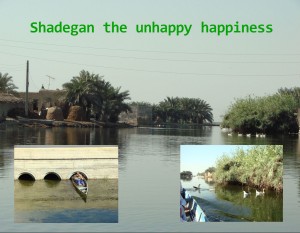It has been nearly two decades since Shadegan, Iran’s largest wetland, was listed in Montreux record. The record addresses the endangered waters and is primarily aimed at giving the states heads-up for if they hesitate to take timely and efficient action, not only will they lose the areas listed in the Ramsar international convention, but they also will truly confirm the fact that an internationally important wetland is an extravagance they cannot afford and do not deserve. Haplessly, however, the governors of Pardisan building (Iran’s environmental conservation organization), resting assured of their chairs, have never bowed to such conventions and threats.
I need to mention that the wetland with its area of almost 538000 hectares, covers a little more than one third of the area of all wetlands in Iran which have been internationally recognized and included in the Ramsar convention. Even though Shadegan, with an area of almost 538000 hectares, occupies less than 0.3% of the entire country, it provides a natural habitat for 30% of the all bird population (154 species), 25 % of all mammal population (40 species), and 45% of all fish population (36 species of wetland fish plus 45 species of sea fish). In addition, almost 30 major societies of plants consisting of 110 species (5.1% of Iran’s plants population), 3 species of amphibians, and 9 species of reptiles; and finally 4 different types of shrimps, all on the verge of nonexistence, are amongst inhabitants cohabiting in this matchless habitat. With the prospect of 100000 locals, living within the immediate vicinity of the wetland, who will possibly lose their only source of livelihood for which they have no alternative, the extent and depth of the disaster becomes even more alarming.
Yet the question is what have we done, since the convention, so as to control the situation? Have we been able to control the constant oil spill from old worn out pipes into the area? Have we been able to preserve the wetland’s water right? Have we thwarted illegal hunting? Have we prevented the sewage from sugar cane, steel and petrochemical industries from entering the wetland? Have we relocated the residential areas inside the wetland elsewhere? Have we built the infrastructure required to create an affluent eco-tourism? Have we issued sufficient permits or given enough freedom of action to environment conservation NGOs? Have we given a single thought to the existence of 30 petrochemical units and their subsequent pollution in the area? Have we…?
Do we need to review the answers to all these questions? Do I really need to tell you that the water entering Shadegan has decreased by nearly 30% and that the quality of the remaining water is in fact so poor that it is virtually impossible to find a living thing? Last year, I (author) had the chance of riding over the lake by boat twice and two hours each time. Much to my regret, not even one single living creature could be seen slithering amongst the water to promise a brighter future. By the same token, the studies on the sweet water part of Shadegan conducted by Aquaculture Research Center of Southern Iran in 1995, 2008 and 2010 show significant decline in the quality and quantity indices confirming the extent of the critical situation; These studies also indicate a biomass production rate of about 4.5 times less than previous years.
It is even more saddening to learn that owing to the opening of Omidieh refinery, the wetland is now losing another 6583000 m3 of its annual water right which is no doubt a good reason to give the authorities in charge of Iran’s environmental conservation a standing ovation for their remarkable determination to preserve our motherland’s ecological capacity!!! Apparently Shadegan will no longer be “happy” and Iran will continue to be the record holder for the number of wetlands still standing on the Montreux register! We are, however, surprisingly enough still living a healthy and prosperous life, aren’t we?!

